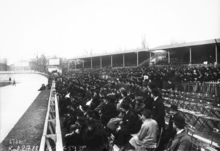Dubonnet Cup

The Dubonnet Cup was an invitational English football exhibition cup game held between 1910 and 1912 held in Paris.
The game was an annual event the aim of which was to generate interest in the French amateur football leagues and helped lead to the establishment of the French Football Federation.
Trophy
The cup is a large vase trophy[1] which weighs in at approximately 112lbs or 50kg.[2]
- "It is of massive design, weighing nearly a cwt., and its style is distinctly French. It is not, perhaps, so attractive and polished a trophy as one might have expected, and when the players themselves first saw it displayed on the Paris ground, and guarded by a Gendarme with drawn sword! they did not (in the words of the popular Secretary) think much of it. But a close inspection is sufficient to show that it is a beautiful work of art. It is a facsimile of an historic cup which is now in the British Museum."[2]
In the years that followed, the trophy resided at the Swindon Town clubhouse, until it was lost in 1992. By 1997, it was back in the Town fold.[3]
Finals
Swindon Town and Barnsley were invited to compete for the cup following both teams' performances in the FA Cup of 1910. Swindon and Barnsley both lost to the eventual winners Newcastle United, Swindon in the Semi-final and Barnsley being Runners-up.
Both clubs sent full-strength teams to Paris for the competition,[4] and played with the cup being guarded at the pitch side.
Harold Fleming scored both of Swindon's goals[5] with Lilycroft scoring for Barnsley.
- "The Frenchmen seem to have been highly delighted with the match, which was not in any sense a 'holiday game.' Barnsley played vigorous football, but completely lost their heads towards the finish, when the Town led by 2–1, especially after Boyle had missed a penalty. The kick was given against Tout for handling, but Boyle shot straight into Skiller's hands."[2]
- "The five thousand spectators who, in spite of the rain, witnessed the Swindon-Barnsley match were able to say that they had seen a really good game of Association football. For an hour and a half it was a typical representation of the English national game. It was not an exhibition of football; it was a well-fought game. If it was possible to describe such an encounter, we should do it, because it was an admirable education for our players, who have seen how far one is able to go in the art of playing football. It gave great satisfaction to the French amateurs"[6]
- "Mr Allen, the Swindon secretary, did not hide from me, after the match, the pleasure it gave him to take this magnificent Cup back to Swindon. Boyle, the efficient Barnsley captain, could not conceal his disappointment of not winning the Cup."[6]
Swindon went on to become Runners-up in the following season's Charity Shield match versus Manchester United.[5]
On 7 May 1911 Clapton Orient beat Millwall 3–0 to win the Dubonnet Cup with goals from Fred Parker, George Scott and Phil Prior before 12 000 Paris fans {Source: Neilson Kaufman, historian Leyton Orient F.C.}
Swindon and Barnsley met again in the FA Cup Semi-final of 1911–12 with Barnsley winning the replay match 1–0.[7] Barnsley went on to win the competition.[8]
References
- ↑ "Dubonnet Cup". Photo Gallery. swindon-town-fc.co.uk. Retrieved 16 January 2007.
- 1 2 3 4 "Bringing home t' Cup". Swindon Advertiser. 9 May 1910. Retrieved 16 January 2007.
- ↑ "Bill Shankly, Swindon Town and the World Cup". Liverpool v Barnsley official matchday programme. Liverpool F.C. 22 November 1997. Retrieved 8 August 2015.
- ↑ "Dubonnet Cup winning squad". Photo Gallery. swindon-town-fc.co.uk. Retrieved 16 January 2007.
- 1 2 "The life & times of Swindon Town's own England International". CommuniGate. thisiswiltshire.co.uk. Retrieved 16 January 2007.
- 1 2 The Auto (Paris) (12 May 1910). "Swindon v. Barnsley". Swindon Advertiser. Retrieved 16 January 2007.
- ↑ "Fleming's way". thisisstfc. Swindon Advertiser. Archived from the original on 3 January 2005. Retrieved 16 January 2007.
- ↑ "FA Cup Final 1912". fa-cupfinals.co.uk. Retrieved 16 January 2007.